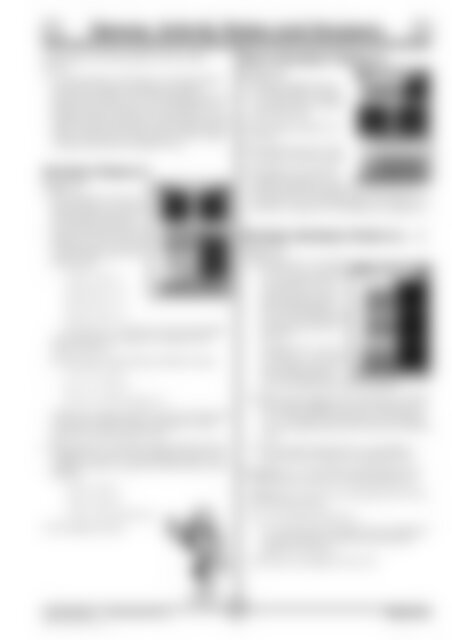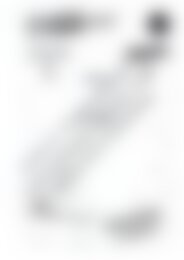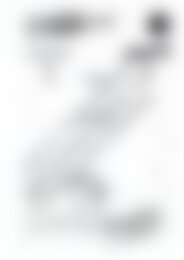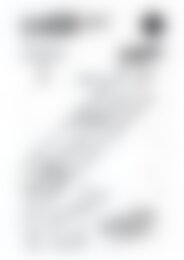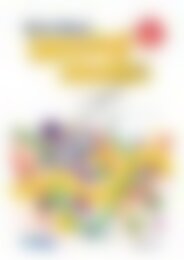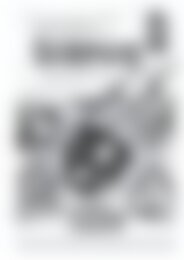You also want an ePaper? Increase the reach of your titles
YUMPU automatically turns print PDFs into web optimized ePapers that Google loves.
Games, Activity Notes and Answers<br />
Further ideas for looking at patterns within number<br />
patterns:<br />
• A useful extension to this idea is to provide students<br />
with a blank 100 grid and ask them to shade in<br />
squares according to a rule. The shaded grid may then<br />
be passed on to a friend to work out the pattern. For<br />
example, a pattern that starts in the top left corner and<br />
moves across two and down one (as a knight moves in<br />
chess), will produce the same pattern as the multiples<br />
of twelve. Note also the multiples of four.<br />
Multiple Patterns<br />
Page 47<br />
1. The multiples of nine form a<br />
diagonal pattern running from<br />
the top right to the bottom<br />
left of the grid because the<br />
grid is ten columns wide. The<br />
multiples of nine are related<br />
to the multiples of ten in the<br />
following way;<br />
1 x 9 = 1 x 10 – 1<br />
2 x 9 = 2 x 10 – 2<br />
3 x 9 = 3 x 10 – 3<br />
4 x 9 = 4 x 10 – 4<br />
5 x 9 = 5 x 10 – 5 and so on, hence the multiples<br />
of nine step back one square, two squares, three<br />
squares and so on.<br />
A similar pattern exists with the multiples of eleven;<br />
1 x 11 = 1 x 10 + 1<br />
2 x 11 = 1 x 10 + 2<br />
3 x 11 = 1 x 10 + 3 and so on.<br />
Therefore, the diagonal pattern moves from the top left<br />
to the bottom right of the grid, stepping in an extra<br />
square as it moves down the rows.<br />
2. When placed on a grid that is eight columns wide the<br />
multiples of nine form a similar diagonal pattern to the<br />
multiples of eleven on a grid ten columns wide. This is<br />
because:<br />
1 x 9 = 1 x 8 + 1<br />
1 x 9 = 1 x 8 + 2<br />
1 x 9 = 1 x 8 + 3 and so on.<br />
3. The multiples of seven.<br />
More Multiple Patterns<br />
page 48<br />
1. A diagonal pattern running<br />
from the top right of the grid<br />
to the bottom left is created,<br />
beginning at eight.<br />
2. More diagonal patterns are<br />
formed.<br />
3. The digit sums for 8, 17, 26,<br />
35 and so on all add to eight.<br />
4. The digit sum for the other<br />
multiples will depend on the<br />
starting number. For example, if you start at five and<br />
then add nine, the following sequence is formed; 5, 14,<br />
23, 32, 41, 50 and so on. The digit sum is always five.<br />
Multiple Multiple Patterns – 1<br />
page 49<br />
1. (a) Multiples of 2 – 2, 4, 6, 8,<br />
10, 12, 14,16 ,18, 20, 22,<br />
24, 26, 28, 30, 32, 34,<br />
36, 38, 40, 42, 44, 46,<br />
48, 50, 52, 54, 56, 58,<br />
60, 62, 64, 66, 68, 70,<br />
72, 74, 76, 78, 80, 82, 84,<br />
86, 88, 90 ,92, 94, 96,<br />
98, 100<br />
Multiples of 3 – 3, 6, 9,<br />
12, 15,18, 21, 24, 27, 30,<br />
33, 36, 39, 42, 45, 48,<br />
51, 54, 57, 60, 63, 66,<br />
69, 72, 75, 78, 81, 84, 87, 90, 93, 96, 99<br />
(b) When all the multiples of two and three are shaded,<br />
the numbers shaded twice are the multiples of six –<br />
6, 12, 18, 24, 30, 36, 42 and so on. The multiples<br />
of six are shaded because two and three are factors<br />
of six.<br />
(c) They are odd numbers that are not multiples of<br />
three. (The even numbers are multiples of two.)<br />
2. Multiples of 4 – 4, 8, 16, 20, 24, 28, 32, 36, 40, 44,<br />
48, 52, 56, 60, 64, 68, 72, 76, 80, 84, 88, 92, 96<br />
Multiples of 6 – 6, 12, 18, 24, 30, 36, 42, 48, 54, 60,<br />
66, 72, 78, 84, 90, 96<br />
(a) 12, 24, 36, 48, 60 and so on.<br />
The numbers that are shaded twice are multiples of<br />
12. This is because 12 is the Lowest Common<br />
Multiple of four and six.<br />
(b) They are not multiples of four or six.<br />
R.I.C. Publications www.ricgroup.com.au<br />
24<br />
<strong>Number</strong> <strong>Grids</strong><br />
ISBN 978-1-86311-826-2


